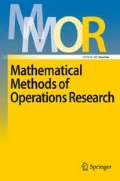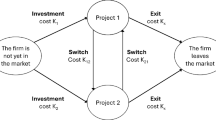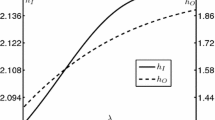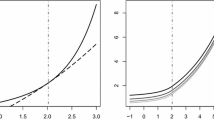Abstract
We develop a complete analysis of a general entry–exit–scrapping model. In particular, we consider an investment project that operates within a random environment and yields a payoff rate that is a function of a stochastic economic indicator such as the price of or the demand for the project’s output commodity. We assume that the investment project can operate in two modes, an “open” one and a “closed” one. The transitions from one operating mode to the other one are costly and immediate, and form a sequence of decisions made by the project’s management. We also assume that the project can be permanently abandoned at a discretionary time and at a constant sunk cost. The objective of the project’s management is to maximise the expected discounted payoff resulting from the project’s management over all switching and abandonment strategies. We derive the explicit solution to this stochastic control problem that involves impulse control as well as discretionary stopping. It turns out that this has a rather rich structure and the optimal strategy can take eight qualitatively different forms, depending on the problems data.








Similar content being viewed by others
Notes
Using a trivial re-parametrisation, we can allow for the project to yield a constant payoff rate while it is in its “closed” mode (see Remark 1).
For the same reason, it would make sense in some economic applications to allow for at least \(K_0\) to be negative, as long as \(K_1 + K_0 > 0\). However, such a relaxation would add most significant complexity and would result in a substantially longer paper.
Although this setting is convenient for the problem’s formulation, switching followed by immediate abandonment is never optimal due to the strict positivity of \(K_\ell \), \(\ell = 1, 0\).
The inequality \(\vartheta < n\), where n is defined by (15), is essential for the value function to be finite.
In the description of the five possible regions, we characterise subsets of \(]0,\infty [\) as open or closed relative to the topology on \(]0,\infty [\) that is the trace of the usual topology on \(\mathbb {R}\), for instance, \(]0,a] = ]0,\infty [ \setminus ]a, \infty [\) and \([a, \infty [ = ]0,\infty [ \setminus ]0, a[\) are closed sets.
We use the notation \(\delta _\dagger \) rather than the simpler \(\delta \) because this point will appear in assumptions that we will make in later cases.
References
Bayraktar E, Egami MA (2010) On the one-dimensional optimal switching problem. Math Oper Res 35:140–159
Brekke KA, Øksendal B (1994) Optimal switching in an economic activity under uncertainty. SIAM J Control Optim 32:1021–1036
Brennan MJ, Schwartz ES (1985) Evaluating natural resource investments. J Bus 58:135–157
Carmona R, Ludkovski M (2008) Pricing asset scheduling flexibility using optimal switching. Appl Math Finance 15:405–447
Dixit AK, Pindyck RS (1994) Investment under uncertainty. Princeton University Press, Princeton
Djehiche B, Hamadène S (2009) On a finite horizon starting and stopping problem with risk of abandonment. Int J Theor Appl Finance 12:523–543
Djehiche B, Hamadène S, Popier A (2009) A finite horizon optimal multiple switching problem. SIAM J Control Optim 48:2751–2770
Duckworth K, Zervos M (2001) A model for investment decisions with switching costs. Ann Appl Probab 11:239–260
El Asri B (2010) Optimal multi-modes switching problem in infinite horizon. Stoch Dyn 10:231–261
El Asri B, Hamadène S (2009) The finite horizon optimal multi-modes switching problem: the viscosity solution approach. Appl Math Optim 60:213–235
Elie R, Kharroubi I (2014) BSDE representations for optimal switching problems with controlled volatility. Stoch Dyn 14:1450003
Gassiat P, Kharroubi I, Pham H (2012) Time discretization and quantization methods for optimal multiple switching problem. Stoch Process Appl 122:2019–2052
Guo X, Tomecek P (2008) Connections between singular control and optimal switching. SIAM J Control Optim 47:421–443
Hamadène S, Jeanblanc M (2007) On the starting and stopping problem: application in reversible investments. Math Oper Res 32:182–192
Hamadène S, Zhang J (2010) Switching problem and related system of reflected backward SDEs. Stoch. Process Appl 120:403–426
Johnson TC, Zervos M (2007) The solution to a second order linear ordinary differential equation with a non-homogeneous term that is a measure. Stochastics 79:363–382
Johnson TC, Zervos M (2010) The explicit solution to a sequential switching problem with non-smooth data. Stochastics 82:69–109
Knudsen TS, Meister B, Zervos M (1998) Valuation of investments in real assets with implications for the stock prices. SIAM J Control Optim 36:2082–2102
Korn R, Melnyk Y, Seifried FT (2017) Stochastic impulse control with regime-switching dynamics. Eur J Oper Res 260:1024–1042
Lumley RR, Zervos M (2001) A model for investments in the natural resource industry with switching costs. Math Oper Res 26:637–653
Ly Vath V, Pham H (2007) Explicit solution to an optimal switching problem in the two-regime case. SIAM J Control Optim 46:395–426
Martyr R (2016) Finite-horizon optimal multiple switching with signed switching costs. Math Oper Res 41:1432–1447
Pham H (2007) On the smooth-fit property for one-dimensional optimal switching problem. In: Séminaire de Probabilités XL. pp 187–201
Pham H, Ly Vath V, Zhou XY (2009) Optimal switching over multiple regimes. SIAM J Control Optim 48:2217–2253
René A, Campi L, Langrené N, Pham H (2014) A probabilistic numerical method for optimal multiple switching problems in high dimension. SIAM J Financ Math 5:191–231
Song QS, Yin G, Zhang Q (2009) Stochastic optimization methods for buying-low-and-selling-high strategies. Stoch Anal Appl 27:523–542
Tang SJ, Yong JM (1993) Finite horizon stochastic optimal switching and impulse controls with a viscosity solution approach. Stochastics 45:145–176
Trigeorgis L (1996) Real options: managerial flexibility and strategy in resource allocation. MIT Press, Cambridge
Tsekrekos JM, Yannacopoulos AN (2016) Optimal switching decisions under stochastic volatility with fast mean reversion. Eur J Oper Res 251:148–157
Zervos M (2003) A problem of sequential entry and exit decisions combined with discretionary stopping. SIAM J Control Optim 42:397–421
Zhang Y (2015) Entry and exit decisions with linear costs under uncertainty. Stochastics 87:209–234
Zhang H, Zhang Q (2008) Trading a mean-reverting asset: buy low and sell high. Automatica 44:1511–1518
Acknowledgements
We thank an anonymous referee and an associate editor for comments and suggestions that enhanced our original manuscript. The research of Carlos Oliveira was supported by Fundação para a Ciência e Tecnologia through the Grant SFRH/BD/102186/2014.
Author information
Authors and Affiliations
Corresponding author
Rights and permissions
About this article
Cite this article
Zervos, M., Oliveira, C. & Duckworth, K. An investment model with switching costs and the option to abandon. Math Meth Oper Res 88, 417–443 (2018). https://doi.org/10.1007/s00186-018-0641-5
Received:
Accepted:
Published:
Issue Date:
DOI: https://doi.org/10.1007/s00186-018-0641-5




